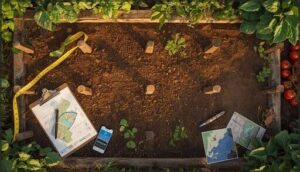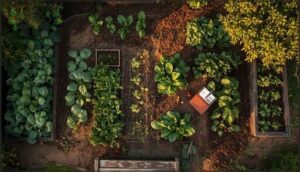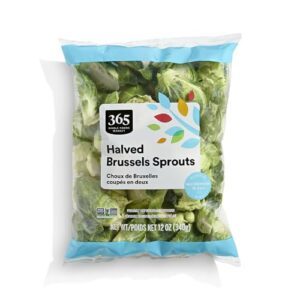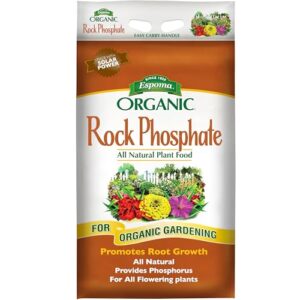This site is supported by our readers. We may earn a commission, at no cost to you, if you purchase through links.
Most gardeners treat their beds like a blank canvas each season, planting tomatoes where tomatoes grew last year, then wondering why yields drop and pests multiply. But soil doesn’t reset between seasons—it remembers. The microbes, nutrients, and pest populations all carry forward, creating an environment that favors the same problems year after year.
Planning a crop rotation schedule breaks this cycle entirely. By deliberately moving crops to different beds and timing your plantings strategically, you rebuild soil health, cut pest pressure by up to 55%, and watch yields jump by an average of 20%. The trick isn’t complicated—it’s just a matter of knowing what goes where and keeping track of what you’ve planted.
Table Of Contents
Key Takeaways
- Crop rotation increases yields by an average of 20% while reducing pest pressure by up to 55% by deliberately moving crops to different beds and breaking pest life cycles.
- Organizing crops by plant family and categorizing them as heavy feeders, light feeders, or soil builders creates a nutrient-balanced rotation that rebuilds soil organic matter by up to 8.5% annually.
- A documented planting history tracked through garden logs, soil testing, and digital tools transforms crop rotation from theory into data-driven practice that eliminates guesswork and reduces input costs.
- Three to five-year rotation sequences adapted to your specific climate, space constraints, and soil conditions provide the foundation for long-term soil health, disease prevention, and consistent harvests.
Key Principles of Crop Rotation Planning
Planning a successful crop rotation starts with understanding the core principles that make this practice so effective.
These foundational concepts will guide every decision you make, from choosing which crops to plant together to timing your planting sequences throughout the year.
Let’s explore the key principles that will set your rotation schedule up for long-term success.
Benefits of Crop Rotation for Soil Health
When you rotate crops strategically, you’re basically rebuilding your soil from the ground up. Diversified crop rotation increases soil organic matter by up to 8.5% and boosts microbial biomass considerably—the living engine that drives soil fertility.
Strategic crop rotation rebuilds soil from the ground up, increasing organic matter by up to 8.5% and boosting the microbial biomass that drives fertility
Better soil structure means improved water retention and erosion control, reducing your vulnerability to drought and runoff. Implementing these strategies can greatly reduce soil erosion.
The result? Yields jump by an average of 20%, and your soil gains the resilience to handle whatever climate challenges come your way.
Crop Families and Nutrient Requirements
Different plant families pull nutrients from your soil in distinct ways. Tomatoes and peppers demand heavy potassium and nitrogen, while cabbage and broccoli are nitrogen hogs requiring 30g/m² per season. Legumes work differently—they actually replenish nitrogen, supplying 30–60 kg/ha through natural fixation.
Here’s what matters for your rotation nutrient balance:
- Heavy feeders deplete soil quickly; follow them with soil builders
- Root depth varies by family, accessing different nutrient layers
- Light feeders like carrots need minimal nitrogen, perfect for recovery beds.
Implementing crop rotation helps with pest and disease control.
Disrupting Pest and Disease Cycles
Now here’s where crop rotation gets practical: pests and diseases don’t travel well. When you move your tomatoes away from last year’s location, the soil-dwelling pests starve out. That western corn rootworm drops 80% when you rotate out of corn for a season. Three-year rotations reduce potato diseases greatly.
You’re fundamentally playing hide-and-seek with pathogens, breaking their life cycles before they establish. Strategic rotation scheduling—especially with legumes—reduces pest pressure by up to 55%, cutting pesticide needs in half.
Impact on Yield and Soil Structure
Here’s the payoff: your yields jump an average of 20% when you rotate versus monoculture. Four-year rotations push corn yields up 48%.
Beyond the numbers, you’re rebuilding soil from the ground up. Rotation increases soil organic matter, improves aggregate stability, and cuts erosion losses by 60%.
Nutrient cycling gets sharper too—iron, magnesium, and zinc levels rise 27%, 17%, and 17% respectively. Stronger soil structure means better water infiltration and root penetration.
You’re not just growing more; you’re growing smarter.
Steps to Design a Crop Rotation Schedule
Now that you understand why crop rotation matters, it’s time to build your actual plan.
The next steps walk you through the practical side of designing a schedule that works for your specific garden or field. We’ll cover everything from mapping your space to sequencing your crops in a way that maximizes soil health and minimizes pest problems.
Mapping Your Garden or Field Plots
Before you design your rotation, you need to see what you’re working with. Start by mapping your garden or field plots—this is where everything begins. Measure your boundaries carefully, checking width at both top and bottom to account for irregularities.
Record your plot layout using one of these methods:
- Hand-drawn sketches with measuring tape and compass
- Digital tools like Google Drawings or Draw.io
- GPS-based apps for precise bed locations
- Satellite imagery overlaid with hand-drawn zones
Accurate garden maps reduce errors by up to 15% and create the foundation for tracking what you’ve planted where, season after season. This historical record becomes invaluable when planning your rotation sequences.
Identifying and Grouping Crops by Family
Think of crop families as botanical cousins sharing similar pest susceptibilities and nutrient demands. Grouping crops by family—Solanaceae (tomatoes, peppers), Brassicaceae (cabbage, broccoli), Fabaceae (beans, peas), and Cucurbitaceae (squash, cucumbers)—lets you rotate strategically.
Members within each family share disease risks and attract comparable insects, so alternating plant families disrupts pest life cycles effectively. Extension guides recommend minimum three-year rotation intervals for most families, though Brassicaceae may need longer gaps in disease-prone areas.
This family-based approach simplifies your planning while maximizing pest control and companion planting opportunities.
Categorizing Heavy Feeders, Light Feeders, and Soil Builders
Now that you’ve organized crops by family, categorize them by nutrient demands to reveal your rotation’s real power. Heavy feeders like tomatoes and corn deplete soil nitrogen by up to 40% annually, so they’re your rotation’s starting point.
Light feeders—lettuce, peas—demand minimal nutrients and thrive after heavy feeders.
Soil builders like legumes and rye restore nitrogen by 45–81 kg/ha, replenishing what you’ve harvested. This three-part system balances nutrient needs while strengthening soil health year after year.
Planning Rotation Sequences (3-year, 4-year, 5-year)
Your rotation length directly shapes success. A 3-year sequence boosts yields 10–15%, while 4-year rotations cut pest pressure by 59%. For maximum soil health outcomes, consider 5-year crop rotation plans that build microbial diversity and break tough disease cycles.
When designing rotation sequences, integrate legumes strategically—they reduce nitrogen needs by 25% while delivering 21% yield gains. Match three-year, four-year, or longer cycles to your climate and pest pressures for sustainable, productive results.
Essential Records and Tools for Rotation Success
Good crop rotation plans aren’t built on memory alone—they’re built on records. Keeping track of what you planted where, how things performed, and what problems showed up gives you the real data you need to make smarter decisions each season.
Here are the essential tools and practices that’ll help you stay organized and get the most out of your rotation system.
Keeping a Garden Log and Planting History
Your garden’s memory matters more than you might think. A detailed garden journal tracking planting dates, crop families, and seasonal results becomes invaluable for maintaining effective rotation schedules.
Record keeping through digital tools or printable formats lets you map which crops occupied each bed year after year, capture pest history and yield tracking by location, and perform economic analysis on your investments.
This documented planting history eliminates guesswork and transforms crop rotation from theory into practice.
Soil Testing and Nutrient Analysis
Your soil tells the story your crops can’t. Regular soil tests reveal nutrient deficiencies that limit yield outcomes and guide targeted fertilizer strategies. Annual basic testing catches pH shifts and organic matter changes, while thorough assessments every three to five years track deeper soil health indicators.
Test-driven nutrient management reduces input costs, prevents over-application, and boosts yields by 10–30% compared to untested fields. When you know your soil’s actual fertility status, you make smarter decisions about crop placement and nutrient needs.
Using Digital or Printable Planning Tools
Once you’ve tested your soil, digital tools and printable charts make planning your rotation schedule faster and more accurate. Farm mapping software lets you visualize crop placement across multiple seasons, while decision support systems improve sequences based on your soil data and farm scale.
Many platforms generate printable garden layouts you can post in your shed, track annually, and adjust over time. Whether you’re managing a small bed or larger plots, these visual aids keep your rotation strategy organized and actionable.
Tracking Pest, Disease, and Yield Outcomes
Beyond planning, your real control comes from tracking what actually happens in the field. Recording pest incidence metrics, disease severity, and yield outcomes each season reveals which rotations work best for your land. This data-driven approach transforms guesswork into strategy.
- Monitor field conditions systematically to catch pest pressure early
- Log crop performance annually to identify patterns and adjust sequences
- Use predictive analytics tools that link historical records to yield forecasts
Your records become the foundation for smarter crop rotation schedules year after year.
Adapting Crop Rotations to Your Garden
Not every garden is the same, and neither should your rotation plan be. The real challenge isn’t just knowing the principles—it’s making them work in your actual space, with your specific conditions and constraints.
Let’s look at how you can adapt crop rotation to fit your garden’s unique situation.
Managing Limited Space and Small Beds
When space is tight, spatial zoning transforms constraint into strategy. Divide your small beds into three or four zones, rotating crop families annually so each returns only after years pass.
A 4-by-4 raised bed splits into sixteen squares, each hosting different families. Intensive planting and succession plantings within zones multiply yields fivefold compared to traditional layouts.
Block-style design eliminates wasted paths, maximizing productive area while your pest management stays tight and disease cycles break naturally across rotations.
Integrating Cover Crops and Fallow Periods
Your rotation plan gains real power when you introduce cover crops and fallow period alternatives. Rather than leaving beds bare, winter legumes fix nitrogen while spring cover crops build organic matter—boosting yields by 20% on average.
Here’s what works:
- Plant nitrogen-fixing legumes before heavy feeders
- Replace fallow with short-season crops for $144–$303 per hectare gains
- Integrate grazing cover crops to optimize economic returns
This approach strengthens soil health while protecting your investment.
Matching Rotations to Local Climate and Seasons
Your local climate shapes everything about your rotation schedule. Cool-season crops like lettuce thrive at 10–18°C, while warm-season varieties need 18–27°C—timing matters. Check your frost dates and growing season length to position sensitive crops during safer windows.
Drought-resilient rotations with deep-rooted and shallow-rooted crops improve moisture retention. Short-season varieties let you replant if early weather disrupts plans. Match crop choices to your climate zone for stability across unpredictable seasons.
Troubleshooting Common Crop Rotation Challenges
Even well-intentioned rotations stumble when reality meets planning. You’ll encounter nutrient imbalances if you skip soil testing, pest buildup when rotation intervals fall short, and soil degradation from poor residue management.
Market constraints and equipment limitations often derail diversified plans. That’s why careful record keeping matters—track what worked, what didn’t, and adjust accordingly.
Disease prevention hinges on rotating outside plant families, not just switching crops. Start simple, document everything, improve yearly.
Top 6 Products for Effective Crop Rotation
Planning a solid crop rotation schedule is one thing, but having the right tools and supplies makes actually executing it so much easier.
We’ve gathered six products that’ll help you track your rotations, build healthier soil, and keep your plants thriving season after season. Here’s what works best for making your rotation plan stick.
1. Fresh Halved Brussels Sprouts Bag
Brussels sprouts are a brassica powerhouse in any crop rotation schedule. These fresh halved sprouts deliver impressive nutritional composition—83% of your daily vitamin C, plus fiber, potassium, and iron—making them valuable both nutritionally and agronomically.
Their pest management benefits are significant: rotating them disrupts soil-borne diseases like clubroot specific to brassicas. Market trends show surging demand, especially November through December. For storage quality, keep them at 32°F for three to four weeks.
Plan your crop sequence around brassicas carefully; they’ll thrive when rotated after legumes and light feeders, breaking disease cycles effectively.
Best For: Home cooks and meal preppers looking for a convenient, nutrient-dense vegetable that works well in a variety of cooking methods and fits easily into healthy eating routines.
- Packed with vitamin C (83% daily value) and fiber, making them a genuinely nutritious choice that supports overall health
- Pre-halved for convenience, so you save prep time and can get them into the pan or oven quickly
- Versatile in the kitchen—roast them, sauté them, microwave them, or throw them in soups without much fuss
- They need to be washed before eating, which adds an extra step compared to grab-and-go snacks
- Not ideal for raw consumption in smoothies, so your cooking options are more limited than some other vegetables
- Storage window is fairly tight—you’ve got 3 to 4 weeks in the fridge before they start losing quality, so you need to plan ahead
2. Organic Fish Emulsion Plant Fertilizer
Fish emulsion fertilizer strengthens your rotation system by rebuilding soil fertility after heavy feeders deplete nutrients. This sustainably sourced amendment—with a 2-3-1 NPK ratio—delivers readily available macronutrients and trace minerals that stimulate beneficial soil microbes.
You’ll see yield increases of 10-15% compared to synthetic options, plus improved organic matter and water retention. Applied every 2-4 weeks during growth, it costs $40-90 per acre seasonally.
Over 45% of organic farmers now rely on fish emulsion, making it an economically sound, certified-organic choice that bolsters long-term soil health and productivity.
Best For: Organic farmers and gardeners looking to rebuild soil fertility, increase yields by 10-15%, and maintain certified-organic certification while supporting sustainable agriculture.
- Cold-pressed formula retains nutrients, vitamins, and amino acids with a 2-3-1 NPK ratio that supports steady plant growth and stimulates beneficial soil microbes
- Cost-effective at $40-90 per acre per season with proven yield increases of 10-15% and improved soil structure for long-term productivity
- Biodegradable, low carbon impact, and recycles fish processing waste—making it an environmentally responsible choice that reduces chemical reliance
- Strong fishy smell can be unpleasant during application and handling
- Some customers report leakage during shipping, requiring careful receiving and storage precautions
- Higher upfront cost compared to synthetic fertilizers ($25-50 per acre) and requires consistent application every 2-4 weeks during growing season
3. Espoma Rock Phosphate Organic Plant Fertilizer
Phosphorus is the unsung hero of root development and flowering, yet many rotations overlook it. Espoma Rock Phosphate delivers a 3% phosphate concentration from natural deposits, offering an organic phosphorus source that corrects deficiencies without synthetic chemicals.
Apply 2.5 pounds per 100 square feet to established beds, or 4 teaspoons per plant at planting time. This sustainable agriculture approach enhances soil pH and fertility over multi-year cycles.
Pelletized for easy spreading, it’s available nationwide—making nutrient management in crops accessible and environmentally sound for your rotation plan.
Best For: Organic gardeners and farmers looking to boost root development, flowering, and long-term soil fertility without synthetic chemicals.
- Natural, organic phosphorus source (3% P2O5) derived from sustainable deposits with no fillers or sludges
- Pelletized form reduces dust and makes application easy—just spread at 2.5 lbs per 100 sq ft or 4 teaspoons per plant
- Improves soil health, pH balance, and multi-year crop fertility while supporting better fruit yield and plant establishment
- May require online purchase since local availability varies, and some customers report receiving dirty or damaged packaging
- Dust inhalation is a concern during application, so proper handling and protective measures are necessary
- Environmental impact of phosphate mining includes fluoride and heavy metal releases; runoff can contaminate water sources if not managed carefully
4. Gardening Log Book Planner
Without a system to track what you’ve planted where, crop rotation becomes guesswork. A gardening log book planner transforms your rotation planning into data-driven management by documenting planting dates, locations, and outcomes year after year.
You’ll capture pest documentation, yield tracking, and garden maps that reveal patterns—like which beds drain poorly or where disease strikes repeatedly.
This record-keeping benefits your future decisions, reducing fertilizer inputs by up to 25% while boosting yield efficiency. Your garden journal becomes your rotation’s roadmap, turning experience into reproducible success.
Best For: Gardeners who want to organize their planting schedules, track crop rotation systematically, and use data from past seasons to make smarter decisions about what grows where.
- Helps you spot patterns in pest problems and disease outbreaks, so you can rotate crops more effectively and potentially reduce repeat issues by 30–40%
- Keeps all your garden information in one place—planting dates, harvest quantities, locations—making it easy to compare year-over-year results and boost yield efficiency
- Covers everything you need without overwhelming you, with guided prompts for plant logs, seasonal checklists, and a companion planting chart that fits right in your pocket at 6×9 inches
- Requires consistent, ongoing effort to actually fill out the pages—if you skip weeks or seasons, you’ll lose the continuity that makes the data useful
- The paper and print quality may feel cheap to some, and the layout might not match exactly how you prefer to organize your specific garden information
- Being analog means no digital search, photo attachments, or easy backup—if you lose the book or prefer working on your phone, this won’t work for you
5. Andersons HumiChar Organic Soil Amendment
Your garden log reveals patterns, but soil itself needs rebuilding. That’s where HumiChar steps in—a blend of humic acid and biochar that addresses the foundation crop rotation creates.
This organic amendment improves soil pH, boosts microbial activity, and increases organic matter permanently. You’ll see turf density improve within weeks while reducing fertilizer needs by up to 30%.
The granular formula applies easily without tilling, making it ideal for rotation planning. With coverage up to 12,000 square feet per bag, it’s a practical investment in long-term soil fertility and sustainable gardening success.
Best For: Gardeners and homeowners who want to rebuild soil health, reduce fertilizer use, and improve lawn or crop performance without harsh chemicals or heavy tilling.
- Improves soil structure and nutrient retention permanently, reducing fertilizer needs by up to 30% within two years
- Easy granular application with no raking or tilling required, plus OMRI certified organic for sustainable growing
- Noticeable results fast—turf density and color improve within weeks, with long-term benefits lasting decades
- Not available in California or Oregon, and considered pricey compared to standard fertilizers
- Requires multiple applications and patience for optimal long-term results rather than quick fixes
- Biochar’s upfront cost is high, though it does pay for itself over time through reduced fertilizer spending
6. Live Edible Herb Plant Assortment
Your rotation plan works best when you can harvest fresh ingredients year-round. That’s where a live edible herb assortment fits perfectly into your garden strategy.
These six-pack collections—usually featuring basil, mint, lemon balm, and other culinary varieties—arrive fully rooted and ready for planting indoors or out. They’re grown using sustainable methods that minimize water and chemicals, aligning with your crop rotation goals.
Since herbs regenerate quickly under proper light, you’ll enjoy continuous harvests while maintaining the diversity your soil health plan demands.
Best For: Home gardeners, cooking enthusiasts, and anyone looking to grow fresh herbs year-round with minimal space and maintenance.
- Fully rooted and ready to plant, so you get started immediately without waiting for seeds to germinate
- Herbs like basil and mint regrow quickly with regular harvesting, giving you continuous fresh ingredients for cooking
- Sustainable production methods use up to 95% less water than traditional farming, making this an eco-conscious choice
- Plants may arrive stressed or damaged from shipping, requiring some TLC before they settle in
- Requires consistent light (at least 6 hours daily) and proper watering to thrive, or they’ll struggle and underperform
- The specific herb varieties can change based on what the nursery has in stock, so you might not always get exactly what you expect
Frequently Asked Questions (FAQs)
How do I handle perennial crops in my rotation plan?
Treat perennial phases as separate management blocks within your rotation map, since they occupy fields for years or decades.
Use cover crops or interseeding between rows to maintain soil health and manage pests where physical rotation isn’t practical, ensuring your long-term planning accounts for different return times across fields.
Can I rotate crops in containers or raised beds?
Absolutely. Containers and raised beds can achieve strong yields—5 to 5 kg per square meter—when you rotate plant families. Rotating reduces soilborne disease by 28–50% compared to continuous cropping.
Even replacing 50% of soil annually, rotation limits pathogen buildup. Follow simple 3–4 year patterns within confined spaces for measurable disease reduction.
How do weather patterns affect my rotation schedule?
Have you noticed how shifting temperatures are reshaping what thrives where?
Temperature impacts on your growing season directly affect rotation benefits—corn rotation gains drop up to 17% in warming climates, while soybean benefits increase.
Adjust planting dates based on soil temperature rather than fixed calendar dates for best results.
Should I use cover crops between rotation cycles?
Cover crops between rotation cycles actively rebuild your soil while suppressing pests and improving water management.
They increase organic matter by 7–74%, boost yields by up to 3 bushels per acre, and reduce erosion substantially—making them a cornerstone of sustainable agriculture practices.
Conclusion
Your garden isn’t a stage reset each season—it’s a living story that writes itself into the soil. When you plan a crop rotation schedule with intention, you’re not just shuffling plants around; you’re actively rewriting that story toward health and abundance.
Every season builds on the last, creating richer soil, fewer pests, and harvests that reflect your deliberate care. This practice transforms gardening from reactive to authorial.
- https://www.nature.com/articles/s41467-025-64567-9
- https://cropwatch.unl.edu/2021/more-diverse-crop-rotations-improve-yield-yield-stability-and-soil-health/
- https://phys.org/news/2025-11-crop-rotation-higher-yields-nutrition.html
- https://pmc.ncbi.nlm.nih.gov/articles/PMC9995906/
- https://www.frontiersin.org/journals/sustainable-food-systems/articles/10.3389/fsufs.2021.647335/pdf
















